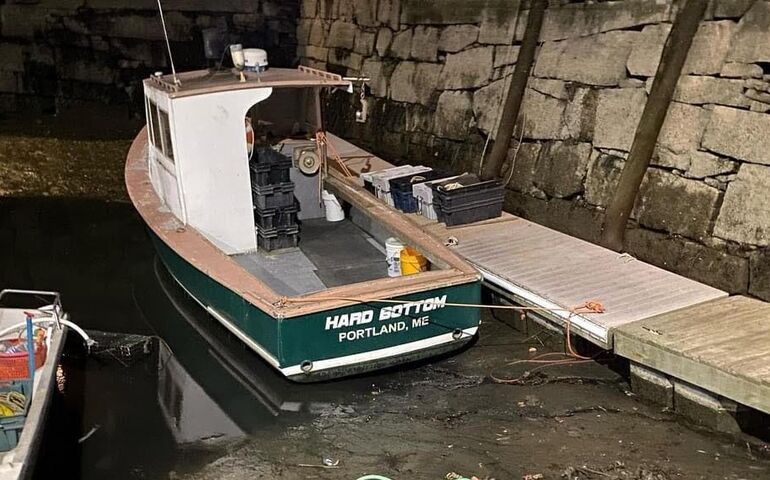Portland one step closer to harbor dredging, deemed essential to working waterfront
 Courtesy / City of Portland
A substantial amount of commercial berthing in Portland Harbor is unusable because of sediment build-up. A new permit puts the city closer to harbor dredging to fix the situation.
Courtesy / City of Portland
A substantial amount of commercial berthing in Portland Harbor is unusable because of sediment build-up. A new permit puts the city closer to harbor dredging to fix the situation.
The city of Portland has received state and federal approvals that bring it a step closer toward dredging piers, wharfs and waterfront properties in Portland Harbor.
Green lights from the U.S. Army Corps of Engineers and the Maine Department of Environmental Protection, announced Thursday, allow Portland and its partners to build a “confined aquatic disposal cell,” or CAD cell. It's basically a deep hole dredged into the harbor into which contaminated material is permanently deposited.
Portland Harbor has received maintenance dredging in recent years, but there’s been no comprehensive clean-up of the seafloor around piers and wharves in living memory, officials have said.
The total CAD cell and harbor dredge project would cost in the neighborhood of $30 million. A recent economic assessment of Portland Harbor estimated the direct and indirect economic output from the waterfront economy at approximately $1 billion annually.
“We’re losing the best berths in the harbor,” Bill Needelman, Portland’s waterfront coordinator, said in a news release. “Commercial vessels want to be in protected water and that’s where sedimentation is the most rapid.”
The solution for sediment buildup in any harbor is dredging. However, any dredged sediment needs to be disposed of, and urban sediments are typically contaminated with pollution from roads, rooftops and “legacy” pollution from long-departed industries.
Without CAD cells, critical infrastructure rehabilitation that requires dredging is cost prohibitive for many New England communities.
Portland’s CAD cell will be the first in Maine.
According to Needelman, in Portland’s central waterfront alone, over 3,000 linear feet of commercial berthing — which is parking for a vessel — is now entirely unusable due to sediment build-up. Additional vessel support space that was previously built for large vessels is now only functional for smaller boats due to decreased water depths.
The city has been working for years with South Portland, the state and the Portland Harbor Commission to find a solution for dredging the piers, wharfs and waterfront properties in Portland Harbor.
Portland City Manager Jon Jennings started work on the dredge project while working for the city of South Portland more than seven years ago.
“We need to get the dredging done,” said Jennings. “We don’t have a choice. Receiving the CAD cell permits from the Army Corps of Engineers and the Maine Department of Environmental Protection positions both cities to receive the funding needed to move forward.”
Similar conditions exist on the South Portland side of the harbor where sedimentation has caused a significant reduction in commercial pier and dock berthing space as well as marina berthing space.
City Manager Scott Morelli said that, with more than 1,000 boat slips at five marinas, South Portland’s waterfront businesses are an important contributor to the local and regional economy bringing many seasonal slip tenants as well as many short-term marine visitors to the city.
People in the boating community, Morelli noted, not only support local marinas but also shop in local stores, eat at restaurants and more.
South Portland’s economic development director, Bill Mann, said that, in addition to the restoration of economic vitality of the harbor’s berthing space, the project would have significant environmental clean-up benefits. Morelli and Mann praised the strong level of collaboration among project partners.
CAD cells form an important part of the equation in the rehabilitation and maintenance of many historic ports with successful projects, like the New Bedford and Boston harbors in Massachusetts.
The material dredged from the CAD cell during construction is clean and can be disposed of at the “Portland Disposal Site” located 6 miles off Cape Elizabeth in federal waters.
The final project permit from the Army Corps of Engineers for the dredging of the piers and wharves themselves is expected in May of this year.
The Maine DEP has already issued a permit to the Portland Harbor Commission for dredging of the berthing on both sides of the Fore River. The Harbor Commission’s Army Corps permit will be issued in time for application for federal funding.
The project applied for federal funding in 2020 but was not successful. Having permits in hand will better position the project for success in 2021, officials said. Notice for the federal funding was issued Monday by the U.S. Department of Transportation, with applications due in July.









0 Comments